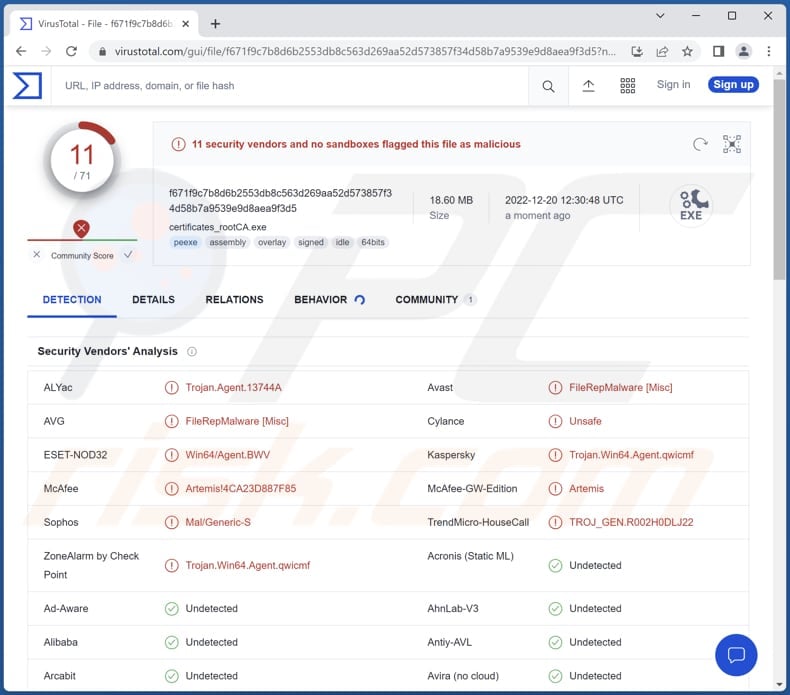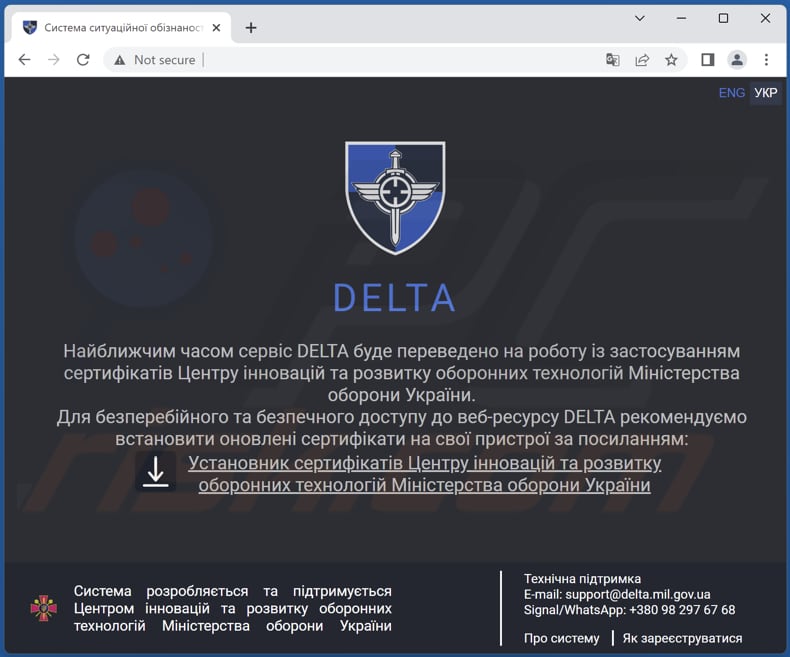Get free scan and check if your device is infected.
Remove it nowTo use full-featured product, you have to purchase a license for Combo Cleaner. Seven days free trial available. Combo Cleaner is owned and operated by RCS LT, the parent company of PCRisk.com.
What kind of malware is FateGrab?
FateGrab is the name of an information-stealing malware distributed along with another stealer called StealDeal. Threat actors deliver these malicious programs via email (they use a compromised email address for malware distribution) and messengers. Both FateGrab and StealDeal should be removed from compromised computers immediately.

More about FateGrab
FateGrab is responsible for stealing .cmd, .doc, .docx, .email, .eml, .kdb., .kdbx, .msg, .odt, .one, .pdf, .ps1, .rtf, .txt, .vbs, .xls, and .xlsx files. It steals documents, email messages, Windows Script Host files, databases, and system files. Stolen data is exfiltrated via FTP.
Depending on the data stored in the stolen files, cybercriminals may use it to hijack online accounts, steal identities and money, and for other malicious purposes. As mentioned in the introduction, cybercriminals distribute FateGrab together with FateGrab, which steals browser data and other information.
| Name | FateGrab malware |
| Threat Type | Information stealer |
| Detection Names (Installer/Excutable) | Avast (Win64:Trojan-gen), AVG (Win64:Trojan-gen), ESET-NOD32 (Win64/Agent.BWV), Kaspersky (Trojan.Win64.Agent.qwicmf), Microsoft (Trojan:Win64/CryptInject!MSR), Full List (VirusTotal) |
| Related Domain | delta-storages[.]com |
| Detection Names (delta-storages[.]com) | Avira (Phishing), Combo Cleaner (Phishing), ESET (Malware), Kaspersky (Phishing), Webroot (Malicious), Full List (VirusTotal) |
| Symptoms | Information stealers are designed to stealthily infiltrate the victim's computer and remain silent, and thus no particular symptoms are clearly visible on an infected machine. |
| Distribution methods | Infected email attachments, deceptive website |
| Damage | Stolen personal documents and other files. |
| Malware Removal (Windows) |
To eliminate possible malware infections, scan your computer with legitimate antivirus software. Our security researchers recommend using Combo Cleaner. Download Combo CleanerTo use full-featured product, you have to purchase a license for Combo Cleaner. 7 days free trial available. Combo Cleaner is owned and operated by RCS LT, the parent company of PCRisk.com. |
Info stealers in general
Different information stealers target different data. Typically, they are used to steal login information (e.g., usernames and passwords), credit card details, ID card information, social security numbers, cryptocurrency wallet data, and other sensitive information.
It is important to mention that information-stealing malware can log keystrokes. It can be designed to record keyboard input. In such cases, cybercriminals can steal any data that victims type with their keyboards.
Examples of different information stealers are PureLogs, Nosu, and Doenerium.
How did FateGrab infiltrate my computer?
Threat actors have been observed using email to deliver FateGrab malware. They are using a compromised email address belonging to one of the employees of the Ministry of Defense of Ukraine. Their emails notify recipients that they are supposed to update certain certificates.
Those emails contain a PDF document that contains a link to a website hosting a malicious ZIP file named "certificates_rootca.zip". That archive file contains an executable file ("certificates_rootCA.exe"). A computer becomes infected with FateGrab after launching that executable file.
How to avoid installation of malware?
Double-check emails before opening links or attachments. Download software from official pages and stores only. Keep the operating system and installed programs updated. Do not trust advertisements on shady pages. Avoid downloads from unofficial sites, third-party downloaders, P2P networks, free file hosting websites, and similar sources.
Use reputed security software and scan a computer for threats regularly. If you believe that your computer is already infected, we recommend running a scan with Combo Cleaner Antivirus for Windows to automatically eliminate infiltrated malware.
Website hosting a ZIP file contaning an executable file designed to inject FateGrab:

Instant automatic malware removal:
Manual threat removal might be a lengthy and complicated process that requires advanced IT skills. Combo Cleaner is a professional automatic malware removal tool that is recommended to get rid of malware. Download it by clicking the button below:
DOWNLOAD Combo CleanerBy downloading any software listed on this website you agree to our Privacy Policy and Terms of Use. To use full-featured product, you have to purchase a license for Combo Cleaner. 7 days free trial available. Combo Cleaner is owned and operated by RCS LT, the parent company of PCRisk.com.
Quick menu:
- What is FateGrab?
- STEP 1. Manual removal of FateGrab malware.
- STEP 2. Check if your computer is clean.
How to remove malware manually?
Manual malware removal is a complicated task - usually it is best to allow antivirus or anti-malware programs to do this automatically. To remove this malware we recommend using Combo Cleaner Antivirus for Windows.
If you wish to remove malware manually, the first step is to identify the name of the malware that you are trying to remove. Here is an example of a suspicious program running on a user's computer:

If you checked the list of programs running on your computer, for example, using task manager, and identified a program that looks suspicious, you should continue with these steps:
 Download a program called Autoruns. This program shows auto-start applications, Registry, and file system locations:
Download a program called Autoruns. This program shows auto-start applications, Registry, and file system locations:

 Restart your computer into Safe Mode:
Restart your computer into Safe Mode:
Windows XP and Windows 7 users: Start your computer in Safe Mode. Click Start, click Shut Down, click Restart, click OK. During your computer start process, press the F8 key on your keyboard multiple times until you see the Windows Advanced Option menu, and then select Safe Mode with Networking from the list.

Video showing how to start Windows 7 in "Safe Mode with Networking":
Windows 8 users: Start Windows 8 is Safe Mode with Networking - Go to Windows 8 Start Screen, type Advanced, in the search results select Settings. Click Advanced startup options, in the opened "General PC Settings" window, select Advanced startup.
Click the "Restart now" button. Your computer will now restart into the "Advanced Startup options menu". Click the "Troubleshoot" button, and then click the "Advanced options" button. In the advanced option screen, click "Startup settings".
Click the "Restart" button. Your PC will restart into the Startup Settings screen. Press F5 to boot in Safe Mode with Networking.

Video showing how to start Windows 8 in "Safe Mode with Networking":
Windows 10 users: Click the Windows logo and select the Power icon. In the opened menu click "Restart" while holding "Shift" button on your keyboard. In the "choose an option" window click on the "Troubleshoot", next select "Advanced options".
In the advanced options menu select "Startup Settings" and click on the "Restart" button. In the following window you should click the "F5" button on your keyboard. This will restart your operating system in safe mode with networking.

Video showing how to start Windows 10 in "Safe Mode with Networking":
 Extract the downloaded archive and run the Autoruns.exe file.
Extract the downloaded archive and run the Autoruns.exe file.

 In the Autoruns application, click "Options" at the top and uncheck "Hide Empty Locations" and "Hide Windows Entries" options. After this procedure, click the "Refresh" icon.
In the Autoruns application, click "Options" at the top and uncheck "Hide Empty Locations" and "Hide Windows Entries" options. After this procedure, click the "Refresh" icon.

 Check the list provided by the Autoruns application and locate the malware file that you want to eliminate.
Check the list provided by the Autoruns application and locate the malware file that you want to eliminate.
You should write down its full path and name. Note that some malware hides process names under legitimate Windows process names. At this stage, it is very important to avoid removing system files. After you locate the suspicious program you wish to remove, right click your mouse over its name and choose "Delete".

After removing the malware through the Autoruns application (this ensures that the malware will not run automatically on the next system startup), you should search for the malware name on your computer. Be sure to enable hidden files and folders before proceeding. If you find the filename of the malware, be sure to remove it.

Reboot your computer in normal mode. Following these steps should remove any malware from your computer. Note that manual threat removal requires advanced computer skills. If you do not have these skills, leave malware removal to antivirus and anti-malware programs.
These steps might not work with advanced malware infections. As always it is best to prevent infection than try to remove malware later. To keep your computer safe, install the latest operating system updates and use antivirus software. To be sure your computer is free of malware infections, we recommend scanning it with Combo Cleaner Antivirus for Windows.
Frequently Asked Questions (FAQ)
My computer is infected with FateGrab malware, should I format my storage device to get rid of it?
In most cases, malware can be removed using antivirus software. Thus, it is unlikely that it would be neccessary to format the storage device to remove FateGrab.
What are the biggest issues that malware can cause?
Malware can be designed to encrypt files, steal sensitive information, use computers to mine cryptocurrency, add computers to botnets, drop additional payloads (inject more malware), etc.
What is the purpose of FateGrab malware?
FateGrab steals .cmd, .doc, .docx, .email, .eml, .kdb., .kdbx, .msg, .odt, .one, .pdf, .ps1, .rtf, .txt, .vbs, .xls, and .xlsx files. The purpose of this stealer is to exfiltrate documents, email messages, Windows Script Host files, databases, and system files.
How did a malware infiltrate my computer?
FateGrab is delivered via a compromised email address. Threat actors send emails containing a PDF document. That document contains a link to a website hosting a malicious ZIP file. Computers get infected after opening an executable in that ZIP file.
Will Combo Cleaner protect me from malware?
Yes, Combo Cleaner will detect and remove malware (it can detect almost all known malware). If a computer is infected with high-end malware, it must be scanned using a full scan. Usually, high-end malware hides deep in the system.
Share:

Tomas Meskauskas
Expert security researcher, professional malware analyst
I am passionate about computer security and technology. I have an experience of over 10 years working in various companies related to computer technical issue solving and Internet security. I have been working as an author and editor for pcrisk.com since 2010. Follow me on Twitter and LinkedIn to stay informed about the latest online security threats.
PCrisk security portal is brought by a company RCS LT.
Joined forces of security researchers help educate computer users about the latest online security threats. More information about the company RCS LT.
Our malware removal guides are free. However, if you want to support us you can send us a donation.
DonatePCrisk security portal is brought by a company RCS LT.
Joined forces of security researchers help educate computer users about the latest online security threats. More information about the company RCS LT.
Our malware removal guides are free. However, if you want to support us you can send us a donation.
Donate
▼ Show Discussion